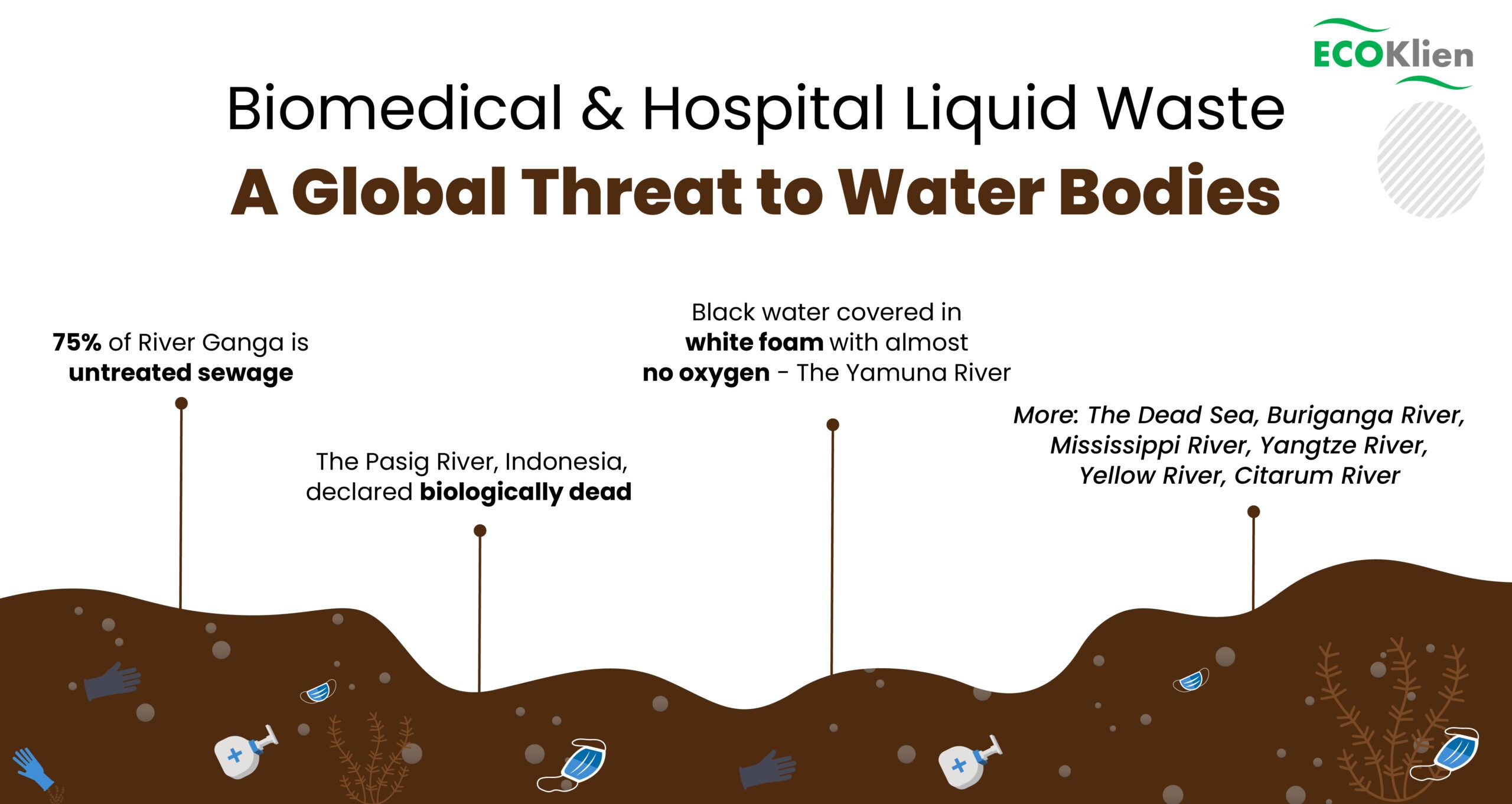
(Prefer video content?Watch THIS…)
Untreated hospital liquid waste and biomedical wastewater is a significant threat to water bodies around the world. According to the World Health Organization (WHO), more than 2 billion people lack access to safely managed sanitation services. This is a particular problem in developing countries, where hospital and biomedical waste management is often inadequate.
Hospital Liquid Waste Composition
A 2019 study published in the journal Environmental Science and Technology found that untreated hospital liquid waste can contain a wide range of pollutants, including:
- Antibiotic-resistant bacteria
- Viruses, such as hepatitis and HIV
- Cytotoxic drugs
- Heavy metals
- Endocrine disruptors
- Total Coliform, Fecal Coliform, E-Coli
- Fecal Streptococci, Enterococci
- Hepatitis A, E
These pollutants can have a devastating impact on water bodies, the ecosystem and the economy.
Let’s take a look around the world. Some of the major water bodies make the list of the most polluted. Listing in no particular order:
These are some of the water bodies that are pillars of the ecosystem. Some of them have already been declared biologically dead while some are in critical danger, affecting everything they touch.
Read on for a more in-depth view of each waterbody or – skip to the solution.
The Ganges/Ganga, India
The Ganges River is a major river in India providing for around 650 million people. Though considered a sacred and holy waterbody, The Ganga is also one of the most polluted in the world. Scientists have discovered ‘super bacteria’ living in the waters that are resistant to most forms of commonly used antibiotics. According to the National Mission for Clean Ganga (NMCG), despite various efforts, over 3/4th of the untreated wastewater still enters the Ganges. This has led to a variety of health problems for people who rely on the river for drinking water and other essential needs. Over the years, the river has also seen multiple species get endangered, The Ganges River Dolphin being the most well-known.
Yamuna, India
The Yamuna River meets the daily needs of 57 million residents. It is estimated that just Delhi, whose primary source of water is Yamuna, discharges over 170 million of gallons of untreated wastewater per day into the river, with a significant amount being hospital and biomedical wastewater. Haryana adds its own with over 540 million liters of untreated wastewater per day. This has led to high levels of pollution in the river, causing it to become a dead river in some seasons. The river water has turned black, covered in white foam, with almost no oxygen. Ammonia levels have risen 5 times over the treatable limit.
Yellow River, China
Called the Cradle of the Chinese Civilisation, the Yellow river is one of the longest rivers in the world. It was also chronically polluted. In recent news, it is said to have improved water quality since the passing of multiple laws and regulations. However, prior to such strict steps, 50% of the river was declared biologically dead. Some areas along the river had a dramatic increase in cancer, birth defects and waterborne disease.
Citarum River, Indonesia
The Citarum is relied on by millions, but just the smell is enough to know the state of the river. A dense odor, dead animals and an unnatural color. Still, around 25 million people depend on it. A river with lead levels more than 1000 times the drinking water standards. From above, the river isn’t even visible, only waste and plastic. But underneath all that, it’s a mix of various toxic compounds from multiple sources.
Buriganga River, Bangladesh
Pitch black water with a foul smell throughout the year indicates the biological death of the Buriganga River in Bangladesh. A 2004 newspaper article pointed out that up to 80 percent of Dhaka’s wastewater was untreated. 4 million people along the river depend completely on it, but the water causes skin diseases, burning and infections.
How to reduce the Threat to Water Bodies?
Let’s start with prioritizing efficient treatment before disposal. Invest in Advanced Wastewater Treatment. Proper infrastructure is a necessity along with its maintenance and management. Set up a system that makes wastewater treatment simple and hassle free. Raising public awareness about the dangers of untreated hospital liquid waste and the importance of proper wastewater management is crucial.
